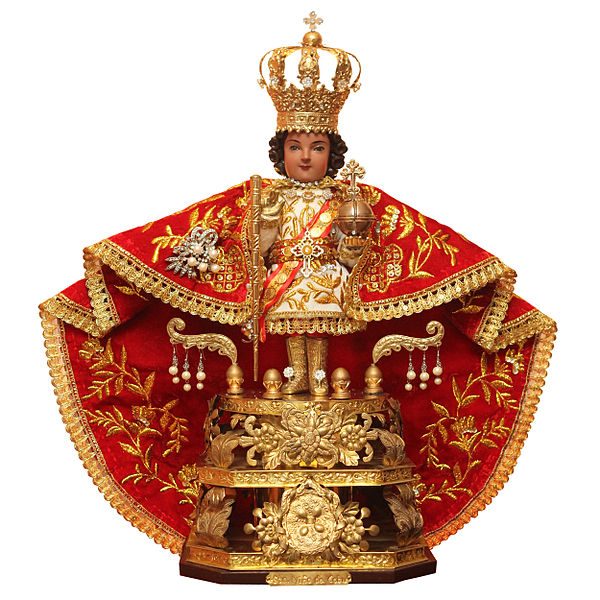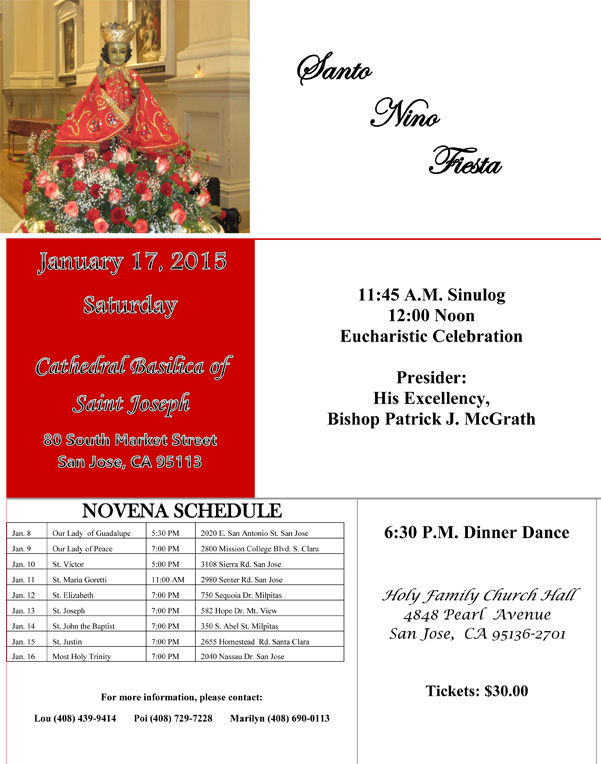The Diocesan Council of Filipino Catholics (DCFC), Diocese of San Jose, invites one and all to the annual celebration of the nine-day Novena of Masses in honor of the Feast of Santo Niño (Holy Child), from January 8 through January 16, 2015 at different parishes. The schedule of the Novena Masses is as follows:

| Day | Date | Parish | Time |
| 1 | Thursday January 8 |
Our Lady of Guadalupe 2020 E. San Antonio St. San Jose |
5:30pm |
| 2 | Friday January 9 |
Our Lady of Peace 2800 Mission College Blvd. Santa Clara |
7pm |
| 3 | Saturday January 10 |
St. Victor 3108 Sierra Rd. San Jose |
5pm |
| 4 | Sunday January 11 |
St. Maria Goretti 2980 Senter Rd. San Jose |
11am |
| 5 | Monday January 12 |
St. Elizabeth 750 Sequoia Dr. Milpitas |
7pm |
| 6 | Tuesday January 13 |
St. Joseph 582 Hope St. Mountain View |
7pm |
| 7 | Wednesday January 14 |
St. John the Baptist 279 S. Main St. Milpitas |
7pm |
| 8 | Thursday January 15 |
St. Justin 2655 Homestead Rd. Santa Clara |
7pm |
| 9 | Friday January 16 |
Most Holy Trinity 2940 Nassau Dr. San Jose |
7pm |
 Grand Eucharistic Concelebration
Grand Eucharistic Concelebration
and Dinner Dance
Saturday, January 17, 2015
Click here to download a flyer.
Bishop Patrick J. McGrath will be the Main Celebrant at the final grand Eucharistic Concelebration on Saturday, January 17, 2015 at 12 PM at the Cathedral Basilica of St. Joseph in downtown San Jose. A colorful procession of the traditional Filipino “Sinulog and Karakol” will take place in the Cathedral at 11:45 AM preceding the Mass. At 6:30 PM, a dinner dance, capping the celebration, will be held at Holy Family Hall, 4848 Pearl Avenue, San Jose.
Ticket is $30 per person available at the door or through DCFC members. For ticket information, please call Poi Buenaventura (408) 729-7228, Lou Concepcion (408) 439-9414, or Marylyn Pablo (408) 690-0113. See you all at the masses and at the Fiesta Finale in honor of our Santo Niño!
———————————————————————-
The Santo Niño de Cebú (Spanish: Holy Child of Cebu) is a Roman Catholic title of Jesus Christ associated with a religious vested statue of the infant Child Jesus venerated by many Filipino Catholics who believe it to be miraculous. It is the oldest religious Christian image in the Philippines, and was originally given in 1521 as a baptismal gift by Portuguese explorer Ferdinand Magellan via Antonio Pigafetta, who physically handed it to Lady Humamay, the principal wife of Rajah Humabon, along with a statue of the Our Lady of Guidance and a Cross. The image merited a Papal recognition on 28 April 1965 when Pope Paul VI issued a papal bull for the Canonical Coronation and Pontifical High Mass via the papal legate to the Philippines, Cardinal Amleto Giovanni Cicognani who concelebrated it’s 400th centennial anniversary. The image measures approximately twelve inches tall, and is believed to be originally made in Flanders, Belgium. The statue is clothed in valuable textiles, and bears an imperial regalia that includes a gold biretta crown, globus cruciger, and various sceptres mostly donated from devotees in the Philippines and abroad. The Santo Niño image is replicated in many homes and business establishments, with different titles reinterpreted in various areas of the country. The Holy Child’s feast is liturgically celebrated every third Sunday of January, during which devotees carry a portable Santo Niño image onto the street fiesta dancing celebrations. The image is one of the most beloved and recognizable cultural icons in the Philippines, found in both religious and secular areas. It is permanently encased within bulletproof glass at the Basilica Minore del Santo Niño.
Discover more about the Holy Child’s story at en.wikipedia.org/wiki/Santo_Niño_de_Cebú
